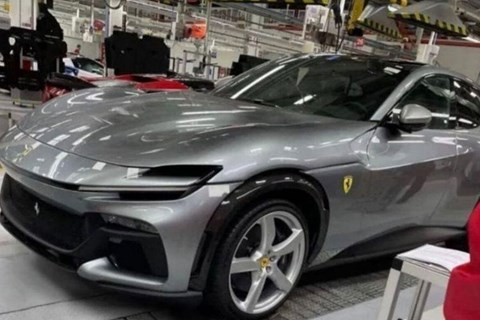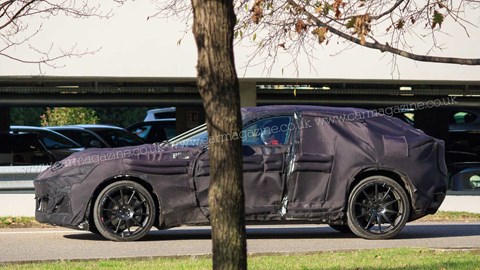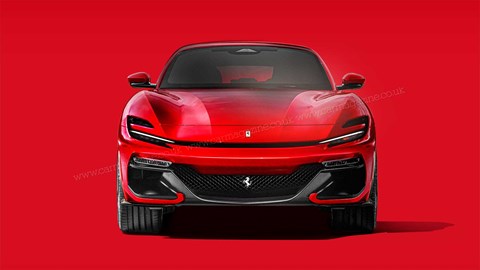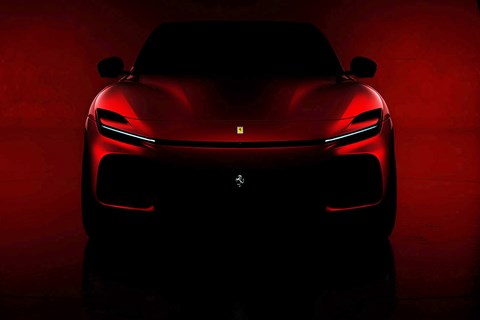► Ferrari SUV ready for September debut
► It’ll be powered by an 800bhp V12
► Will spawn electric crossover spin-offs
Maranello has confirmed it will unveil the long-awaited Ferrari Purosangue ‘SUV’ in September 2022. The company used this summer’s Capital Markets Day to announce a couple of juicy technical details about the car.
The Ferrari Purosangue has now been unveiled – full story here
CEO Benedetto Vigna has confirmed that the Purosangue will launch with a version of Ferrari’s mighty naturally-aspirated V12 under the bonnet.
‘The Purosangue is 100% Ferrari and it will bring several unique features to the market, including our V12 naturally-aspirated engine – our most passionate engine,’ said Vigna. ‘We are confident this will exceed all customer expectations.’
Ferrari Purosangue: V12 power for Maranello’s first SUV
The new CEO, who has held the position since September 2021 and comes from an electronics background, also mentioned that he’d driven the car. ‘It is a car unlike any other,’ continued Vigna. ‘I have driven the car in the hills around here and it really is a sports car.’
CAR magazine’s artist’s impressions, by ace illustrator Andrei Avarvarii, reveal how the Ferrari Purosangue will look once the covers slide off next month. It’s a Ferrari unlike any other – aimed at broader appeal to well-heeled folk with families and dogs who desire ultra-performance with a dose of practicality.
Key to the Purosangue’s implied agility and performance is an innovative suspension system, dubbed FAST – Ferrari Active Suspension Technology. Back in 2018 then CTO Michael Leiters confirmed such a chassis system was in development. Active suspension should allow Maranello’s engineers to solve the tricky physics thrown your way when you give a big, relatively heavy and high-riding car an engine capable of developing some 800bhp…
Active suspension will give Maranello’s engineers complete control over the Purosangue’s ride height and three-dimensional movement as you drive. In corners the system will actively control and minimise roll while also lowering the car, dropping its centre of gravity to increase its ability to deliver high levels of lateral acceleration. The system will also have full control over the car’s front/rear weight transfer, tweaking this balance to maximise corner-exit traction and braking performance.
Vigna’s sentiments were echoed by chief marketing and commercial officer Enrico Galliera. ‘The V12 is the most iconic engine in all Ferrari history, targeted to the most passionate members of our family. The Purosangue will maintain the highest levels of exclusivity and won’t be our most relevant model from a volume standpoint.’
What does the Ferrari SUV look like?
A leaked image (below) circulating earlier in summer 2022 revealed the car’s styling in full on a production line. Until that point, we’d only seen disguised prototype versions of the Ferrari SUV. Early test cars were wrapped in a chopped-up Maserati Levante bodyshell, while our most recently spied development vehicle wore heavy camouflage over the top of production-ready panelling.

The leaked factory image showed that it’ll be lower and more aggressive than all of its competitors, with a design that more closely mimics that of a lifted estate car than a conventional high-riding SUV. Key rivals will include the Bentley Bentayga, Aston Martin DBX and Lamborghini Urus.
Naturally, the project has left Ferrari purists outraged – especially because, just six short years ago, Ferrari promised the world that it would never build an SUV at the 2016 Paris Motor Show. The brand also said it wouldn’t build an electric car, either, but it seems that guarantee is about to expire, too.
Will the Purosangue be electric?
Technically, not at first. Die-hard members of the Ferrari fan club would surely have hung up their branded shirts and caps in shame if Maranello hit them with that double-whammy. The SUV will stick with petrol power, although the chassis that props it up will be capable of supporting a pure-electric powertrain in future. More on that later though – let’s cover the petrol engines first.
So far, we know about two engines. The more exciting one is an 800bhp V12 at launch – but there’s talk also of a hybridised V8. We expect the latter unit will be a modified version of the Roma’s 3.9-litre V8 engine, which means the Purosangue should have an output of at least 611bhp in entry-level form.
As well as forming the basis for the company’s first SUV, the Purosangue’s platform will also usher in the era of electrification at Ferrari. The Italian brand is already working on two related projects built on the same chassis, codenamed F244 and F245.

They’re set to arrive in 2024 and 2026 – and both of them will be fully electric. That flat skateboard floor also means the prospect of a five-seater Ferrari is now tantalisingly close, with fresh rivals for the likes of the Porsche Taycan and Audi e-tron GT possible.
Electric versions of Ferrari’s new platform will have space for four electric motors, which will provide an initial output of 610bhp. The motors will be powered by a scalable, fast-charging lithium-ion battery pack with a base capacity of 80kWh – and that should be enough for a maximum range of more than 260 miles.
A sportier, slinkier type of SUV
Ferrari issued a shadowy teaser photograph in 2022 (flick through our gallery above) and we’ve optimised it in Photoshop to reveal how the SUV will look. Rather than pulling from the Range Rover’s bluff luxury SUV styling book, Ferrari will give the Purosangue a raised-up shooting brake aesthetic.

Late in 2021, Ferrari confirmed ‘Purosangue’ as the working nameplate for its SUV. It translates as ‘thoroughbred’ from Italian and Maranello had to contend with legal discussions over the badge before it could commit.
What else do we know?
The Purosangue has the internal codename of F175, and it’ll have an aluminium platform and all-wheel drive – Ferrari has been quietly developing its four-wheel drive system since it launched the FF in 2011. It’ll be related to the next-generation version of the GTC, and CAR understands that it’ll have suicide back doors and no B-pillars, allowing for a huge entryway for unimpeded access to the rear seats.
Back in 2018, CAR Magazine cornered Louis Camilleri for an interview. The then-new-but- now-departed boss of Ferrari told us: ‘I abhor hearing the word SUV in the same sentence as the Ferrari. It does not sit well with our brand. This vehicle will be unique in so many ways, and it will redefine expectations.’
His comments certainly explain why executives prefer to call the Purosangue an FUV (that’s Ferrari Utility Vehicle… stop sniggering in the back) – and it shows an overwhelming amount of confidence from a brand which doesn’t have any experience in building profitable SUVs.

While some elements of the project, not least its physics-defying suspension, come as no surprise, others are news. For example, the Purosangue will be a niche halo vehicle accounting for less than 20 per cent of shipments, not a Lamborghini Urus or Porsche Cayenne-style volume product.
Nor will it offer much by way of driver assistance beyond Level 2. A self-driving Ferrari simply isn’t, bosses claim, the Maranello way. CEO Vigna: ‘We are not a mobility company. We provide a unique experience. This is key. We will stop at Level 2 plus. We will not go Level 4 or 5. We must always enhance the driving experience, and put the human at the centre of that experience.’
Autonomous driving levels explained
Given Maranello has now confirmed the Purosangue will arrive with Ferrari’s 6.5-litre, turbo-free V12 under the bonnet, being at the centre of this particular driving experience is likely to be quite a privilege…
Why Ferrari can’t ignore the SUV trend
The Ferrari SUV has been a long time coming. Marchionne told analysts in 2017 that a Ferrari SUV ‘will probably happen, but it will happen in Ferrari’s style.’
Like its competitors, Ferrari’s SUV will simply meet customer demand. Marchionne said: ‘That space is too big and too inviting – and we have a lot of customers who will be more than willing to drive a Ferrari-branded vehicle that has that king of utilitarian objective.’
It’ll probably be quite a good moneymaker for the brand, too. Our insiders tell us to expect a starting price of more than €300,000 (£265,000). That’s an awful lot for an SUV that will need to be flawed to match the Ferrari brand image – but it’s just good business.
The addition of an SUV to Ferrari’s range could also help double the company’s sales to around 16,000 units per year by the middle of the decade – which explains why nearly every premium brand going has jumped on the SUV bandwagon.

